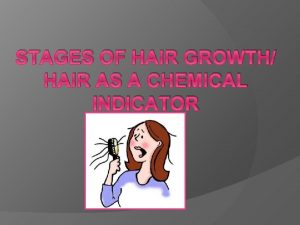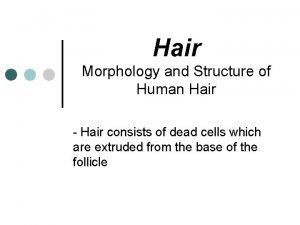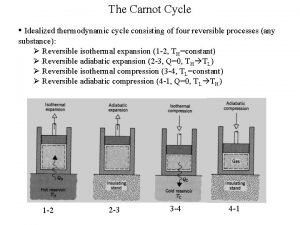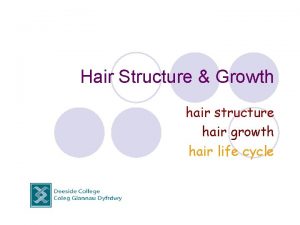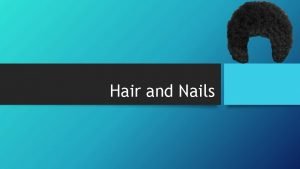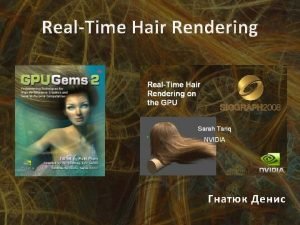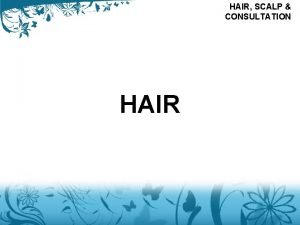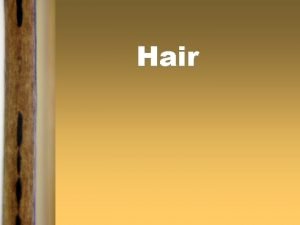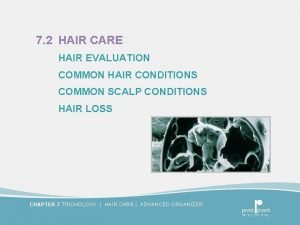Hair Growth The hair growth cycle consists of















- Slides: 15

Hair Growth • The hair growth cycle consists of a growing stage and a resting stage. – Growth cycle = growth stage & resting stage • Growth stage – lasts for 2 to 6 years – matrix cells at base of hair root producing length • Resting stage – lasts for 3 months – matrix cells inactive & follicle atrophies – Old hair falls out as growth stage begins again • normal hair loss is 70 to 100 hairs per day 1

• Both rate of growth and the replacement cycle can be altered by illness, diet, high fever, surgery, blood loss, severe emotional stress, and gender. • Chemotherapeutic agents affect the rapidly dividing hair cells resulting in hair loss. 2

Hair Color • Hair color is due primarily to the amount and type of melanin. • Graying of hair occurs because of a progressive decline in tyrosinase. – Dark hair contains true melanin – Blonde and red hair contain melanin with iron and sulfur added – Decline in melanin production also contributes to graying hair. – White hair has air bubbles in the medullary shaft • Hormones influence the growth and loss of hair. 3

Functions of Hair • Prevents heat loss • Decreases sunburn • Eyelashes help protect eyes • Touch receptors (hair root plexus) senses light touch 4

Glands of the Skin Specialized exocrine glands found in dermis ØSebaceous (oil) glands ØSudiferous (sweat) glands ØCeruminous (wax) glands ØMammary (milk) glands 5

Sebaceous (oil) glands • Sebaceous (oil) glands are usually connected to hair follicles; they are absent in the palms and soles. • Secretory portion of gland is located in the dermis – produce sebum • • • Acne contains cholesterol, proteins, fats & salts moistens hairs waterproofs and softens the skin inhibits growth of bacteria & fungi (ringworm) – bacterial inflammation of glands – secretions are stimulated by hormones at puberty 6

Sudoriferous (sweat) glands Eccrine sweat glands have an extensive distribution most areas of skin – secretory portion is in dermis with duct to surface – ducts terminate at pores at the surface of the epidermis. – regulate body temperature through evaporation (perspiration) – help eliminate wastes such as urea. 7

Apocrine sweat glands are limited in distribution to the skin of the axilla, pubis, and areolae; their duct open into hair follicles. – secretory portion in dermis – duct that opens onto hair follicle – secretions are more viscous 8

Ceruminous Glands • Ceruminous glands are modified sudoriferous glands that produce a waxy substance called cerumen. – found in the external auditory meatus – contains secretions of oil and wax glands – barrier for entrance of foreign bodies • An abnormal amount of cerumen in the external auditory meatus or canal can result in impaction and prevent sound waves from reaching the ear drum (Clinical Application). 9

• Tightly packed keratinized cells Structure of Nails • Nail body – visible portion pink due to underlying capillaries – free edge appears white • Nail root – buried under skin layers – lunula is white due to thickened stratum basale • Eponychium (cuticle) – stratum corneum layer 10

Nail Growth • Nail matrix is below nail root -produces growth • Cells transformed into tightly packed keratinized cells • 1 mm per week 11

• Thin skin TYPES OF SKIN – covers all parts of the body except for the palms and palmar surfaces of the digits and toes. – lacks epidermal ridges – has a sparser distribution of sensory receptors than thick skin. • Thick skin (0. 6 to 4. 5 mm) – covers the palms, palmar surfaces of the digits, and soles – features a stratum lucidum and thick epidermal ridges – lacks hair follicles, arrector pili muscles, and sebaceous glands, and has more sweat glands than thin skin. 12

FUNCTIONS OF SKIN 1. Blood reservoir Ø extensive network of blood vessels 2. Protection - physical, chemical and biological barriers Ø Tightly packed cells prevent bacterial invasion Ø pigment protects somewhat against UV light Ø Langerhans cells alert immune system 3. Cutaneous sensations – detects stimuli Ø touch, pressure, vibration, tickle, heat, cold, and pain arise in the skin 13

FUNCTIONS OF SKIN 4. Synthesis of Vitamin D Øactivation of a precursor molecule in the skin by UV light Øenzymes in the liver and kidneys modify the activated molecule to produce calcitriol, the most active form of vitamin D. Ønecessary vitamin for absorption of calcium from food in the gastrointestinal tract 5. Excretion Ø 400 m. L of water/day, small amounts salt, CO 2, ammonia and urea 14

6. Regulation of body temperature (thermoregulation) • Perspiration & its evaporation Ø lowers body temperature Ø flow of blood in the dermis is adjusted • Exercise Ø in moderate exercise, more blood brought to surface helps lower temperature Ø with extreme exercise, blood is shunted to muscles and body temperature rises • Shivering and constriction of surface vessels Ø raise internal body temperature as needed 15
 Pubic hair growth cycle
Pubic hair growth cycle Morphology hair
Morphology hair Distal tip hair
Distal tip hair Carnot efficiency
Carnot efficiency Hình ảnh bộ gõ cơ thể búng tay
Hình ảnh bộ gõ cơ thể búng tay Bổ thể
Bổ thể Tỉ lệ cơ thể trẻ em
Tỉ lệ cơ thể trẻ em Gấu đi như thế nào
Gấu đi như thế nào Chụp tư thế worms-breton
Chụp tư thế worms-breton Chúa yêu trần thế
Chúa yêu trần thế Môn thể thao bắt đầu bằng chữ đua
Môn thể thao bắt đầu bằng chữ đua Thế nào là hệ số cao nhất
Thế nào là hệ số cao nhất Các châu lục và đại dương trên thế giới
Các châu lục và đại dương trên thế giới Công thức tiính động năng
Công thức tiính động năng Trời xanh đây là của chúng ta thể thơ
Trời xanh đây là của chúng ta thể thơ
